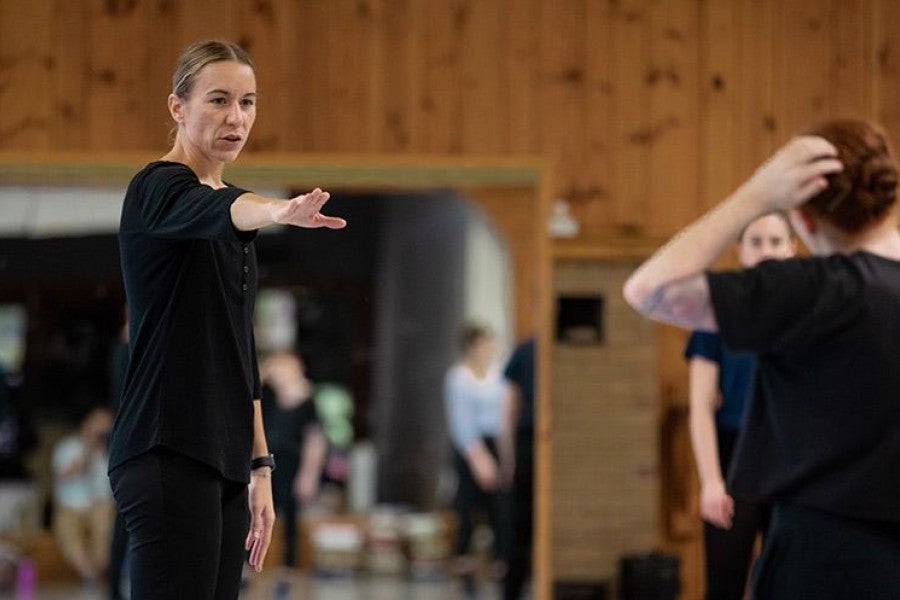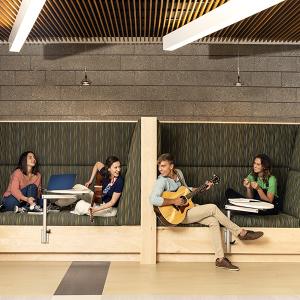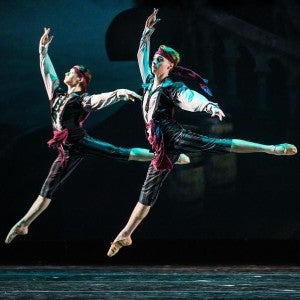Meet your faculty: Katie Dorn
Instructor of Contemporary Dance shares her dance roots, tips for young dancers, and love of kiteboarding.
This August, dancer Katie Dorn joined the Interlochen Arts Academy faculty as Instructor of Contemporary Dance.
Dorn, a ten-year company member of Lucinda Childs Dance, has worked with noted choreographers including Gus Solomons, Jr., Carlos Sotos, and Vanessa Walters. As a repetiteur, she has set Childs’ work at Barnard College, the University of Michigan, Lyon Opera Ballet, and other college and professional companies. Dorn has also taught dance conditioning at Sacred Heart University and is the host of the podcast Dance Journal NYC.
Dorn earned her B.F.A. in Contemporary Dance from the University of North Carolina School of the Arts and her M.F.A. from Hollins University/American Dance Festival.
We sat down with Dorn to learn more about her early dance training, first impressions of Interlochen, and passion for extreme sports.
How did you get started in dance?
I was put into dance when I was very young. My parents are both athletes, and they thought it would be something that I would be able to do without getting injured. They didn’t think it would be something I stuck with, but they’ve been very supportive.
What technique was most difficult for you to master? How did you overcome that challenge?
I grew up doing theatrical dance—tap, jazz, ballet. Instead of really learning technique, we spent time learning choreography for competitions and recitals. I didn’t really understand technique until I was in high school and had the opportunity to work one-on-one with a mentor. The first time we met, all we worked on was plié and learning how to do that properly. It was kind of humiliating, because I had done it a thousand times, but didn’t understand the technical way of doing it using the right muscles.
What drew you to Interlochen?
I was excited about being able to work with students at a young age who have a deep interest and passion for dance. A lot of people feel that if a student is passionate, it doesn’t matter where they’re at in terms of their technique or experience. I want to help them become the best versions of themselves.
What has the experience of working with Interlochen’s young dancers been like so far?
It’s been great! I have loved every moment in the studio so far. Having a full-time contemporary dance instructor is new for these students; some are excited for the challenge, and some are still figuring it out. It’s a different way to approach dance, and they’re gaining an understanding that it’s not ballet. But they’ve been open to change, and it’s been great.
It’s a big time in our dance division. We have two new instructors and a building renovation and expansion about to get underway. How will these new and expanded facilities benefit our dancers?
First, the ceiling will be higher. For exceptionally tall men who are lifting and partnering women, they’ll have enough space to lift and jump without being worried about hitting the ceiling.
One thing we’re talking about is a Pilates studio and conditioning studio. With so much space, students will be able to find a “home base” before heading to the studio. Having all the studios in one building will increase the sense of community for our dancers. The architects are also talking about adding a convertible black-box theatre with lighting that can serve as a performance space, and that would be really cool.
What do you find rewarding about teaching?
I find everything about it really rewarding. I love to share the experiences that I have had as a professional and use them to mentor students; I hope it helps them. I also enjoy having conversations with and getting to know my students. I love watching them figure things out for themselves, making the body-and-mind connection with dance. Watching them grow is especially rewarding.
What are some things that young dancers can do now to aid their future career?
I think if they have and keep an open mind, it will be really helpful. As dancers, the lines between ballet and modern are constantly blurring. It’s important to be a well-rounded dancer and gain experience in as many genres as you can; any type of cross-training will make you more employable. It’s also important to learn how to communicate and articulate thoughts and ideas. In modern dance, many current choreographers will ask company members to develop phrases to help with the creation process.
What’s one thing you always keep in your dance bag?
A lacrosse ball for rolling tight muscles.
What are some of your hobbies outside of dance?
I kiteboard, I also downhill ski and I’m learning to snowboard. I also like knitting and other crafty-type things. I like any kind of outdoor or physical activity.
How do you keep your body safe during more active hobbies like kiteboarding?
I just use common sense. It’s about knowing what your limits are, especially with something extreme like kiteboarding. I try not to do anything crazy out on the water and just enjoy riding. Accidents happen, of course, but you have to trust yourself.
Coffee or tea?
Coffee
Want to meet Katie? Learn more about dance at Interlochen Arts Academy and start your application today!








